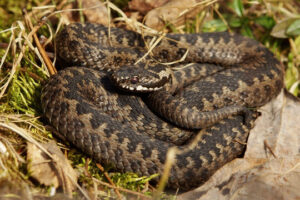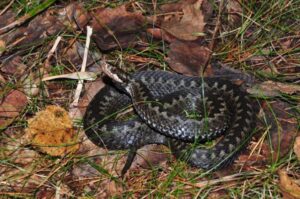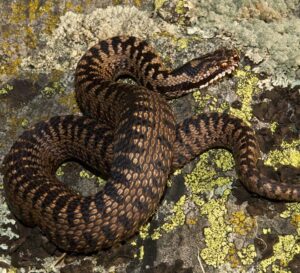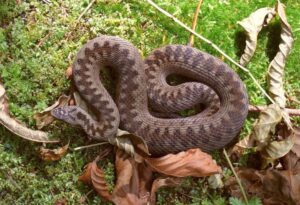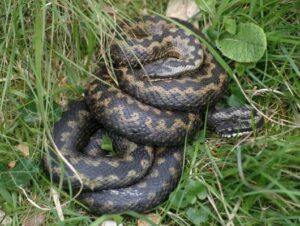The common European adder or common European viper is a
thick-bodied viper that occurs throughout Eastern and Central Europe, as far as East Asia. It is known by a host of names like common viper, common adder, European adder, and adder. The species is mainly diurnal in the northern part of its range, but further south, it is crepuscular and even nocturnal in the summer.
Scientific Classifications
- Suborder:Serpentes
- Family:Viperidae
- Genus:Vipera
- Species:V. berus
Conservation Status
Subspecies
This snake has three recognized subspecies.
- Common European Adder (Vipera berus berus)
- Balkan Cross Adder (Vipera berus bosniensis)
- Sakhalin Island Adder (Vipera berus sachalinensis)
Description
Size
The adults generally grow to a total length of 24 in (60 cm), including the tail. The average length of the species is 22 in (55 cm). The maximum size varies with the region. The largest specimens at over 35 in (90 cm) occur in Scandinavia. Individuals measuring 41 in (104 cm) have been spotted there on two occasions. Their mass varies from 1.8-6.3 oz (50-180 g).
Color and Appearance
The color pattern varies from very light-colored background color with incomplete, small, dark dorsal crossbars to entirely brown ground color with clear or faint, darker brown patterns to melanistic specimens that are completely black with no apparent dorsal markings. However, most of these snakes have a dorsal zigzag pattern down the full length of their body, including the tail.
The sexes can be differentiated by their color, something uncommon for snakes. Females are usually brownish with dark brown patterns, and males are purely grey with black patterns. The ground color of the males is often slightly lighter than the females, making the black zigzag markings stand out. The melanistic individuals are generally females.
The fairly large head is distinct, with almost vertical and flat sides. There is a prominent dark X or V mark at the back of the head. The edge of the snout is usually raised to form a low ridge. When viewed from above, the rostral scale is slightly or not visible. A dark streak extends from the eye to the neck, continuing as a linear series of spots along the flanks.
Are They Dangerous to Humans
It is not considered dangerous as it is not aggressive and tends to be rather timid. Any hint of danger makes it disappear into undergrowth and emerge once everything is quiet. It bites only when extremely provoked, picked up, or stepped upon. The bites, though seldom fatal, can be very painful. When threatened, it draws the front part of its body in an S-shape preparing for a strike. The snakes, mostly the pregnant females, try to warn potential predators by a loud and sustained hissing.
The venom toxicity is relatively low compared to other viper species. The same goes for the venom yield. Systemic symptoms resulting from anaphylaxis can appear within 5 minutes of the bite or be delayed by many hours. They may include retching and vomiting, nausea, incontinence of feces and urine, diarrhea and abdominal colic, fever, sweating, vasoconstriction, lightheadedness, tachycardia, loss of consciousness, shock, blindness, bronchospasm, urticaria, angioedema of the lips, face, gums, throat and epiglottis, and tongue. There may be cardiovascular failure in severe cases.
Common European Adders at a Glance
Distribution
The European adder has a wide distribution. It lives across the Eurasian landmass – from northwestern Europe (Great Britain, Netherlands, Belgium, Scandinavia, France, Germany) across southern Europe (Italy, Albania, Serbia, Croatia, Bosnia and Herzegovina, Montenegro, North Macedonia, northern Greece, and Bulgaria) and eastern Europe to north of the Arctic Circle, and Russia to Sakhalin Island in the Pacific Ocean, northern Mongolia, North Korea, and northern China.
Habitat
The common adder can be found in various habitats – rocky hillsides, chalky downs, sandy heaths, moors, meadows, rough commons, edges of woods, sunny clearings and glades, bushy hedgerows and slopes, coastal dunes, dumps, and stone quarries. It ventures into wetlands if there is dry ground nearby and, therefore, can occur on the banks of lakes, streams, and ponds.
Lifespan
The adder can live for up to 15 years.
Predators
Diurnal birds of prey, foxes, Eurasian badgers, owls, and other larger snakes are its predators.
Diet
The European adder eats birds, small mammals, lizards, and amphibians. It also preys on worms, spiders, and insects sometimes.
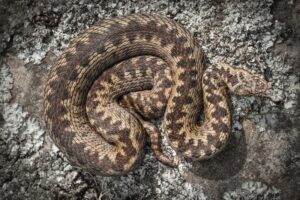
Reproduction
Ovoviviparous (gives birth to live young from eggs that hatch inside the body)
The females breed once every 2-3 years, with litters of 3-20 young being born from late summer to early autumn in the Northern Hemisphere. The neonates measure 5.5-9.1 in (14-23 cm) in total length with an average total size of 6.7 in (17 cm). They have a reserve supply of yolk and a fully functional venom apparatus. They stay with their mother for a few days.
Source
stock.adobe.com, ourbreathingplanet.com, parcostelviotrentino.it, praha.eu, first-nature.com, behance.net

